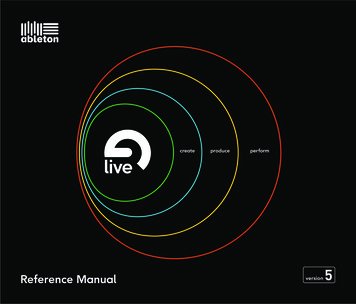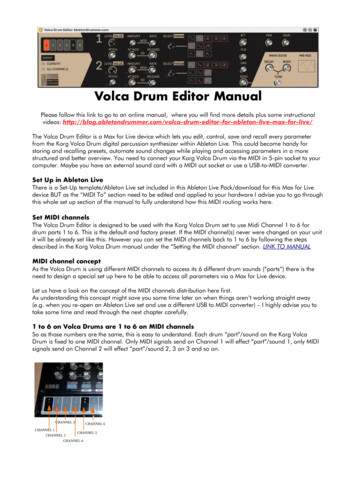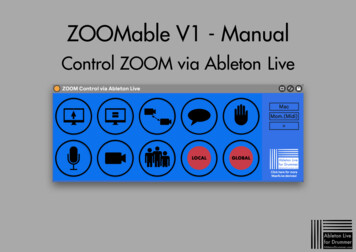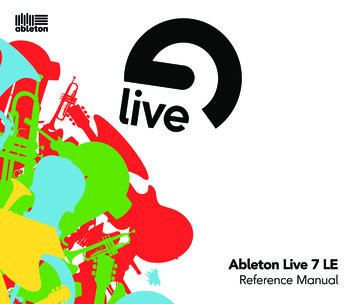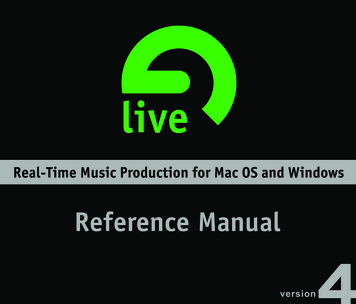
Transcription
1Uhihuhqfh!Pdqxdo
2Live Version 4.1 for Windows and Mac OSCreated by Bernd Roggendorf, Gerhard Behles, Robert Henke, awi, Reiner Rudolph, Stefan Haller,Torsten Slama, Eduard Mueller, Stefan Franke, Frank Hoffmann, Ruotger Skupin, Andreas Zapf, HansThomas Mueller, Henrik Hahn, Ralf Suckow, Gregor Klinke, Matthias Mayrock, Friedemann Schautz.Reference Manual by Rose Knudsen, Gerhard Behles, Jakob Rang, Robert Henke, Torsten Slama.Loops and samples provided by Big Fish Audio.Web: www.bigfishaudio.comE-mail: info@bigfishaudio.comAddress: 11003 Penrose Street, Suite C, Los Angeles, CA 91352MIDI loops provided by Key Fax Inc.Web: www.keyfax.comE-mail: info@keyfax.comAddress: 2400 Chanticleer Ave Suite E, Santa Cruz, CA 95062Copyright 2004 Ableton ag. All rights reserved.This manual, as well as the software described in it, is furnished under license and may be used or copied only in accordance with the termsof such license. The content of this manual is furnished for informational use only, is subject to change without notice, and should not beconstrued as a commitment by Ableton. Ableton assumes no responsibility or liability for any errors or inaccuracies that may appear in thisbook.Except as permitted by such license, no part of this publication may be reproduced, stored in a retrieval system, or transmitted, in any form orby any means, electronic, mechanical, recording, or otherwise, without the prior written permission of Ableton.Macintosh and Audio Units are registered trademarks of Apple Corporation. Windows is a registered trademark of Microsoft Corporation. VST isa trademark of Steinberg Media Technologies AG. ReWire is a trademark of Propellerhead Software. Ableton is a trademark of Ableton ag. Allother product and company names are trademarks or registered trademarks of their respective holders.
Chapter 1Welcome to Live1.1The Ableton Team Says: Thank YouLive is the result of musicians wanting a better way to compose, improvise and perform music usinga computer. A lot of effort has been put into making Live easy and fun to use, yet still capable ofhelping you create music with unlimited depth and sophistication. This effort continues, even asyou are reading these lines. . . in fact, a new, improved Live version might already be available fordownload! Please check on our website now.We hope you enjoy using Live and that it enhances your creative process. Should you have suggestions about how we can improve Live, please let us know.Your Ableton team.1
1.2. WHAT’S NEW IN LIVE 4?1.21.2.12What’s New in Live 4?MIDI Sequencing MIDI tracks and clips (see MIDI Clips and MIDI Files) MIDI recording (see Recording New Clips) Overdub MIDI pattern build-up (see Overdub Recording MIDI Patterns) MIDI note editing and drawing (see Editing MIDI) Instruments and MIDI effects (see Working with Instruments and Effects) MIDI file import (see MIDI Files) and export (see Exporting MIDI Files) MIDI notes can be generated by the computer keyboard (see Playing MIDI With the ComputerKeyboard) MIDI clips can send bank and program changes (see Bank and Program Change)1.2.2Virtual Instruments and Plug-Ins Simpler, for sample-based sound creation (see Simpler) Impulse percussion sampler (see Impulse) VST and Audio Units instrument support (see Using Plug-Ins) Audio Units Plug-in effects supported (Mac OS X) (see Audio Units Plug-Ins) Improved plug-in window handling (see Showing Plug-In Panels in Separate Windows)
1.2. WHAT’S NEW IN LIVE 4?1.2.33Routing, Monitoring and Recording New, flexible track routing and I/O (see Routing and I/O) Audio and MIDI input and output signals can be routed to and from tracks for submixes,layering, etc. (see Internal Routings) Up to twelve sends/returns per Live Set (see Return Tracks and the Master Track) Simplified recording process (see Recording New Clips) Monitoring is managed in the track I/O section (see Monitoring)1.2.4Clip Properties New launch options allow for automatic jamming (see Follow Actions) Groove setting for MIDI and audio clips (see Groove) Reverse button for reversing samples (see Reversing Samples) The Clip View can be vertically resized for editing convenience Follow option acts on Clip View as well as on Arrangement View Easier warping for multitrack samples (see Replacing the Clip’s Sample)1.2.5Session View Session View scenes can store the tempo (see Tracks and Scenes) Session View scenes can be set up to advance automatically (see Tracks and Scenes)
1.2. WHAT’S NEW IN LIVE 4?1.2.64Miscellaneous Loop/Region markers are selectable objects for editing convenience (see The ArrangementLoop) Working with the editing grid has been simplified (see Using the Editing Grid) Tracks can be created by dropping instruments, effects and files on empty mixer space (seeAudio and MIDI Tracks) New, integrated program lessons that cover the key features of Live (see Learn About Live)
Chapter 2First StepsWhen you have installed Live and run it for the first time, you will be presented with the ProductsPreferences tab.If you own Live, you can authorize your copy of the software by selecting it from the listed productsand clicking the “Unlock” button at the bottom of the window. Please see the chapter on unlockingLive (see Unlocking Live) should you have questions or concerns that arise during the unlockingprocess.If you do not (yet) own Live, you can close the Preferences and proceed, as Live will run in DemoMode by default. In Demo Mode, you will be able to work with all of Live’s features with theexception of saving and exporting.5
2.1. LEARN ABOUT LIVE2.16Learn About LiveLive comes with a set of interactive “lessons” that take you step by step through the key featuresof the program. The lessons can be opened via the Help menu or the Demos and Tutorials folder inLive’s File Browser. We highly recommend that you follow these lessons. Many users have told usthe lessons have helped them to get familiar with the program very quickly.A Lesson in the FileBrowser.We also recommend that you read the Live Basics chapter (see Live Basics), which encapsulateseverything that Live is and can do in a single chapter, and is therefore a worthwhile read forboth beginners and experienced users. The remaining chapters of this manual serve as an in-depthreference for the material introduced in the Live Basics chapter.2.1.1Using the Info View and IndexLive’s Info View tells you the name and function of the user interface element currently under themouse.
2.2. THE MAIN LIVE SCREEN7The Info View.If you require more information on a specific user interface element or topic, please consult thisreference manual. The index, found at the end of the reference manual, contains the names of alluser interface elements and will lead you to the relevant section.2.2The Main Live ScreenMost of your work in Live happens in the main Live screen. This screen consists of a number ofviews. Each view manages a specific aspect of your project. As screen space is limited, the otherLive views cannot all be up at the same time.Each one of the selector buttons at the screen borders calls up a specific view; click this one, forinstance, to access the Live devices.A View Selector.To hide one of Live’s views, thus freeing up screen space, click on the triangle-shaped button next
2.3. SET UP AUDIO AND MIDI PREFERENCES8to it. To restore the view, click the button again.A View Show/Hide Button.You can run Live in Full Screen Mode by selecting “Full Screen” from the View menu. To leave FullScreen Mode, click the button that appears in the lower right corner of the screen. Full Screen Modecan also be toggled by pressing the F11 key.You can adjust the main window’s horizontal split by dragging.Adjusting the Main WindowSplit.You can select from among a set of “skins” (color schemes) for Live’s user interface using the MiscPreferences Load Skin chooser. You can also select the system language from the Misc Preferences.2.3Set up Audio and MIDI PreferencesAfter learning about the interface and capabilities of the program, you will probably want to startmaking music. You may want to configure a few preferences before doing so, in order to tell Liveabout your studio hardware. Open the Live Preferences by going to the Options menu (or the Livemenu in Mac OS X) and selecting the “Preferences” option. Please see the Audio Preferences chapter (see Audio Preferences Setup) for the steps to setting up the “Audio” Preferences tab, which allows Live to run audio with your computer andhardware setup. The “MIDI” Preferences tab is used to help Live recognize MIDI devices for three separate anddistinct purposes:– Playing MIDI notes. To learn how to route an external device into Live for MIDI input,please see the chapter on routing (see External MIDI In/Out).
2.3. SET UP AUDIO AND MIDI PREFERENCES9– Controlling parts of the interface remotely. This subject is covered in detail in the chapteron remote control (see MIDI and Key Remote Control).– Syncing the program to an external sequencer or drum machine. Please see the manualsection on sync (see Synchronizing via MIDI) for details.
Chapter 3Unlocking LiveLive is protected against illegal use by a copy protection scheme. This scheme has been designed tomeet the highest security standards while avoiding hassles for the customer. If you find this procedure to be an inconvenience, please understand that the copy protection secures your investment:It allows Ableton to provide you with support and continue developing Live.Authorization of Ableton products takes place in the Preferences’ Products tab, which will appearwhen you start Live for the first time. Here you can choose to authorize (“unlock”) or purchase anyAbleton products available to you, for example the Operator instrument (see Operator).Please note that products such as Operator are sold separately from Live but are unlocked using thesame procedure described in the following sections. If they are available with your version of Live,they will run in Demo Mode by default so that you can try them out.10
11The Products Tab as itAppears Upon Startup.Clicking on any product listed in the Products tab will give you the option of unlocking or buyingthat product. Please click the “Unlock” button here to complete the unlocking process in two steps.If you have not yet purchased the product, you can do so online by clicking the “Buy” button.You can always return to the Products Preferences tab later or visit the Ableton webshop to make apurchase.
3.1. STEP 1: ENTERING YOUR SERIAL NUMBER12Selecting “Unlock” in theProducts Tab.3.1Step 1: Entering Your Serial NumberAs an owner of Live, you have received a Serial Number from Ableton, either via e-mail (if youordered Live directly from Ableton), or on a card as part of the Live package.
3.2. STEP 2: UNLOCKING LIVE13The Fields for Entering YourSerial Number.After selecting “Unlock” in the Products tab, you will be presented with six fields for typing in theSerial Number. Each field holds four characters. The Serial Number is composed of numbers 0.9 andletters A.F. If you accidentally type the wrong string into a field, the field turns red. When you havesuccessfully entered the Serial Number, click the “Ok” button to proceed.The Serial Number identifies your ownership of Live. Because your Serial Number is a valuable good,you should keep it in a safe place and out of reach of unauthorized hands. Please be aware thatsharing your Serial Number will render it unusable. The only way for Ableton technical support to helpyou get back your Serial Number if you lose it is via your registration data. Therefore, please registeryour product, as otherwise you might lose your property!3.2Step 2: Unlocking LiveThe second step of authorizing Live is called “unlocking.” Unlocking means associating your SerialNumber with a specific computer. Please be aware that the standard Live license grants you the rightto use Live on only one computer at a time. You can, however, unlock Live with your Serial Numbermore than once under the legal and technical conditions described later (see Copy Protection FAQs).3.2.1The Unlock KeyFor unlocking, you require an Unlock Key that can only be created by the Ableton server. Unlockingtherefore requires access to the internet. The computer from which you connect to the internet does
3.2. STEP 2: UNLOCKING LIVE14not have to be the same computer for which you wish to unlock Live, but it does make things easier.3.2.2The Challenge CodeThe Ableton server creates the Unlock Key from your Serial Number and a so-called Challenge Code.The Challenge Code is a “fingerprint” that Live takes of your computer’s components. For details,please see the corresponding section (see Copy Protection FAQs).3.2.3Unlocking OnlineUnlocking Live Online.If the computer you want to unlock Live for is connected to the internet, the only thing you need todo is press the “Unlock Online” button. Live will then make a connection to the Ableton server, sendyour Serial Number and Challenge Code to the server, and receive the Unlock Key from the server. Noinformation other than this is exchanged between your computer and the Ableton server.
3.2. STEP 2: UNLOCKING LIVE3.2.415Unlocking OfflineUnlocking Live Offline.If the computer you want to unlock Live for is not connected to the internet, you can use any othercomputer to access the Ableton server’s web interface. This is a website with fields for entering yourSerial Number and the Challenge Code, which you can copy from Live’s Unlock dialog.The Live Unlocking WebSite.If you have entered your Serial Number and Challenge Code correctly, another website will appear to
3.2. STEP 2: UNLOCKING LIVE16provide you with the Unlock Key. There now are two options for transferring the Unlock Key to thecomputer that is to be unlocked:Follow the web link to download the Unlock Key as a file. Transfer the file to the target computer viaa diskette or CD-ROM. Then, press the Unlock dialog’s “Load Unlock Key” button to load the UnlockKey file.The Unlock Key Can BeDownloaded as a Text File.OR it might be more convenient to print the webpage with the Unlock Key on it. On the targetcomputer, press the “Enter Unlock Key” button to open a dialog with fields for typing in the UnlockKey. Typing it in is easier than it first appears because the fields turn red if you type the wrongstring.
3.3. COPY PROTECTION FAQS17Manually Enter Your UnlockKey.3.33.3.1Copy Protection FAQsCan I Run Live Without a Serial Number?If you do not (yet) own Live, you can work with Live in Demo Mode. Demo Mode offers Live’scomplete functionality, but saving and exporting are disabled. Live will run in Demo Mode bydefault if it has not been authorized.
3.3. COPY PROTECTION FAQS18Click Here if You AreInterested in Buying Live.If running Live in Demo Mode raises your interest in purchasing the full version of Live, pleaseselect Live from the Products Preferences tab, and then click the “Buy” button, or visit the Abletonwebshop. This site contains information about Ableton’s distributor and dealer network. It alsooffers you the opportunity to buy Live online.3.3.2What if I Change My Computer’s Components?If the Challenge Code of your computer changes for some reason, Live will indeed ask you to unlockthe software another time (see Can I Unlock Live More Than Once?). The Challenge Code doesnot change, however, when computer peripherals are replaced (audio or MIDI hardware, printers,
3.3. COPY PROTECTION FAQS19modems). The Challenge Code may change if the motherboard, processor or network card is replaced.On some computers, reformatting a hard drive also changes the Challenge Code.3.3.3Can I Unlock Live More Than Once?The standard Live license allows you to use Live on only one computer at a time. If you haveregistered your product, the Ableton server will, however, provide you with two Unlock Keys ingood faith that you will use Live on only one machine at a time. Just proceed as described in thecorresponding section (see Step 2: Unlocking Live).You can, therefore, run Live on both a studio desktop computer and a tour laptop, but not at thesame time. If you are using a Macintosh and switching back and forth between OS 9 and OS X, youcan unlock Live on both systems.Should the Ableton server reject your demand for another Unlock Key, please contact Ableton’stechnical support. They can be reached by: E-mail; telephone: 49 (0)30 - 288 763 151 (available Monday to Friday 11 to 15hrs CET); fax: 49 (0)30 - 288 763 11.To speed up the process, please: register your copy of Live; include a brief explanation of the circumstances.To use Live on more than one computer at a time, you require a Secondary License or a Site License.Ableton offers these licenses at special rates. Please contact the sales team for details.
3.3. COPY PROTECTION FAQS3.3.420Can I Play my Set From a Computer That Is not Unlocked?In Demo Mode, you can load and perform a Live Set with no time limitation. You cannot, however,save or export your work. When you go on tour, consider taking along your Live program CD and aCD with the last state of your Live Set(s). In case of an emergency, you can install and run Live onany computer available and play your backup Live Set(s).3.3.5What Do I Do About Problems or Questions Regarding Copy Protection?Please contact technical support. They are happy to help!
Chapter 4Live BasicsThis chapter introduces the essential concepts behind Live. We advise you to read this chapter earlyin your Live career, as a solid understanding of the program’s basic principles will help you fullyexploit Live’s potential for your music-making.4.1Live SetsThe type of document that you create and work on in Live is called a Live Set (see Creating andSaving Sets). Live Sets can be opened either through the File menu’s Open command or via thebuilt-in File Browsers. Several Live Sets are installed with Live and show up in the Browser whenLive is first launched. Double-clicking a Live Set’s name opens that Live Set.21
4.2. ARRANGEMENT AND SESSION4.222Arrangement and SessionThe basic musical building blocks of Live are called clips. A clip is a piece of musical material: amelody, a drum pattern, a bass line or a complete song. Live allows you to record and alter clips,and to create larger musical structures from them: songs, remixes, DJ sets or stage shows.A Live Set consists of two environments that can hold clips: The Arrangement is a layout of clipsalong a musical timeline; the Session is a real-time oriented “launching base” for clips. Every Sessionclip has its own play button that allows launching the clip at any time and in any order. Each clip’sbehavior upon launch can be precisely specified through a number of settings (see Launching Clips).Clips in the Session View(Left) and in theArrangement View (Right).The Arrangement is accessed via the Arrangement View (see Arrangement View) and the Session viathe Session View (see Session View); you can toggle between the two views using the computer’sTab key or their respective selectors. Because the two views have distinct applications, they eachhold individual collections of clips. However, it is important to understand that flipping the viewssimply changes the appearance of the Live Set, and does not switch modes, alter what you hear orchange what is stored.The Arrangement andSession View Selectors.Arrangement and Session interact in useful (though potentially confusing) ways. One can, forinstance, improvise with Session clips and record a log of the improvisation (see Recording Sessions
4.3. TRACKS23into the Arrangement) into the Arrangement for further refinement. This works because Arrangementand Session are connected via tracks.4.3TracksTracks host clips and also manage the flow of signals, the creation of new clips through recording,sound synthesis, effects processing and mixing.A Track in the ArrangementView.Session and Arrangement share the same set of tracks. The tracks are vertically laid out from left toright in the Session View, and horizontally from top to bottom in the Arrangement View. A simplerule governs the cohabitation of clips in a track:A track can only play one clip at a time.Therefore, one usually puts clips that should play alternatively in the same Session View column,and spreads out clips that should play together across tracks in rows, or so-called scenes (see Tracksand Scenes).
4.3. TRACKS24A Scene in the SessionView.The exclusivity of clips in a track also implies that one track, at any time, will either play a Sessionclip or an Arrangement clip, but never both. So, who wins? When a Session clip is launched, therespective track stops whatever it was doing before to play that clip. In particular, if the track wasplaying an Arrangement clip, it will stop it in favor of the Session clip– even as the other trackscontinue to play what is in the Arrangement. The track will not resume Arrangement playback untilexplicitly told to do so.The Play, Stop, Record andBack to ArrangementButtons.This is what the Back to Arrangement button, found in the Control Bar at the top of the Live screen,is for. This button lights up to indicate that one or more tracks are currently not playing theArrangement, but are playing a clip from the Session instead.We can click this button to make all tracks go back to the Arrangement. Or, if we like what we hear,we can capture the current state into the Arrangement by activating the Record button. DisengagingRecord Mode or stopping Live using the Stop button leaves us with an altered Arrangement– as canbe verified by clicking the Play button to replay the Arrangement. (Note that you can also use thecomputer’s space bar to start and stop.) Creating and refining Arrangements by improvising withSession clips is one of Live’s core applications.
4.4. AUDIO AND MIDI4.425Audio and MIDIClips represent recorded signals. Live is dealing with two types of signals: audio and MIDI. Inthe digital world, an audio signal is a series of numbers that approximates a continuous signal asgenerated by a microphone or delivered to a loudspeaker. A MIDI signal is a sequence of commands,such as “now play a C4 at mezzo piano.” MIDI is a symbolic representation of musical material, onethat is closer to a written score than to an audio recording. MIDI signals are generated by inputdevices such as MIDI or USB keyboards.1It takes an instrument (see Working with Instruments and Effects) to convert MIDI signals intoaudio signals that can actually be heard. Some instruments, such as Live’s Simpler, are for chromaticplaying of one sound via the keyboard. Other instruments, such as Live’s Impulse, have a differentpercussion sound assigned to each keyboard key.Audio signals are recorded and played back using audio tracks, and MIDI signals are recorded andplayed back using MIDI tracks. The two track types have their own corresponding clip types. Audioclips cannot live on MIDI tracks and vice versa.Information about inserting, reordering and deleting audio and MIDI tracks is found here (see Audioand MIDI Tracks).4.5Audio Clips and SamplesAn audio clip contains a reference to a sample (also known as a “sound file” or “audio file”). Theclip tells Live where on the computer’s drives to find the sample, what part of the sample to playand how to play it.When a sample is dragged in from one of Live’s built-in File Browsers (see Working with the FileBrowsers), Live automatically creates a clip to play that sample. Prior to dragging in a sample, one1 Foran introduction to digital audio and MIDI, please see http://img.uoregon.edu/emi/emi.php and http://www.midi.org/
4.5. AUDIO CLIPS AND SAMPLES26can audition or preview it directly in the Browser; the switch in the Browser with the headphoneicon activates previewing.Samples are Dragged infrom Live’s File Browsers.Live offers many options for playing samples in exciting new ways, allowing you to create an abundance of new sounds without actually changing the original sample– all the changes are computedin real time, while the sample is played. The respective settings are made in the Clip View (see ClipView), which appears on screen when a clip is double-clicked.
4.6. MIDI CLIPS AND MIDI FILES27An Audio Clip’s Propertiesas Displayed in the ClipView.Many powerful manipulations arise from Live’s warping (see Time-Warping Samples) capabilities.Warping means changing the speed of playback independently from the pitch, or vice versa. The mostelementary use of this technique, and one that requires almost no manual setup, is synchronizingsample loops to the chosen tempo. With a bit more setup, warping allows you to line up any samplewith the chosen tempo, such as a recording of a drunk jazz band’s performance, or to radicallychange the sonic signature of a sound. To verify, change the project tempo while clips are playingby clicking in the Control Bar’s Tempo field and dragging up and down.The Control Bar’s TempoField.4.6MIDI Clips and MIDI FilesA MIDI clip contains musical material in the form of MIDI notes and controller envelopes. WhenMIDI is imported from a MIDI file (see Working with the File Browsers), the data gets incorporatedinto the Live Set, and the original file is not referenced thereafter. In the Live Browsers, a MIDIfile appears as a folder that can be opened to reveal its individual component tracks, which can beselectively dragged into the Live Set.
4.6. MIDI CLIPS AND MIDI FILES28MIDI Files are Dragged infrom Live’s File Browsers.As expected, a MIDI clip’s contents can be accessed and edited (see Editing MIDI Notes andVelocities) via the Clip View, for instance to change a melody or “paint” a drum pattern.A MIDI Clip’s Properties asDisplayed in the Clip View.
4.7. DEVICES AND THE MIXER4.729Devices and the MixerA track can have, not only clips, but also a chain of devices (see Working with Instruments andEffects) for processing signals. Double-clicking a track’s title bar brings up the Track View, whichshows the track’s device chain.The Track View Displayingan Audio Track’s DeviceChain.Live’s built-in audio effects (see Live Audio Effect Reference), MIDI effects (see Live MIDI EffectReference) and instruments (see Live Instrument Reference) are available from the Device Browserand can be dragged from there into the Track View, or onto a Track Title Bar.
4.7. DEVICES AND THE MIXER30Live’s Built-in Devices areAvailable From the DeviceBrowser.You can also use plug-in devices (see Using Plug-Ins) in Live. VST and Audio Units (Mac OS X only)plug-ins are available from the Plug-In Device Browser.
4.7. DEVICES AND THE MIXER31Plug-In Devices areAvailable From the Plug-InDevice Browser.Consider an audio clip playing in an audio track. The audio signal from the clip reaches the leftmostdevice in the chain. This device processes (changes) the signal and feeds the result into the nextdevice, and so on. The number of devices per track is theoretically unlimited. In practice, thecomputer’s processor speed does impose a limit on the number of devices you can use at the sametime, a topic that deserves separate discussion (see Managing the CPU Load). Note that the signalconnections between audio devices are always stereo, but the software’s inputs and outputs can beconfigured to be mono (see Configuring Audio Device Channels).When the signal has passed through the device chain, it ends up in Live’s mixer (see The Live Mixer).As Session and Arrangement share the same set of tracks, so they share the mixer. The mixer can beshown in both views for convenience. To optimize the screen layout, the individual mixer sectionscan be shown or hidden using the View menu’s entries.
4.7. DEVICES AND THE MIXER32The Live Mixer in theArrangement View (Above)and Session View (Below).The mixer has controls for volume, pan position, and sends, which adjust the contribution each cliptrack makes to each return track’s input. Return tracks cannot host clips, only effects. Via theirsends, all tracks can feed a part of their signal into the return track and share its effects.The mixer also includes a crossfader (see Using Live’s Crossfader) that can create smooth transitionsbetween clips playing on different tracks. Live’s crossfader works like a typical DJ mixer crossfader,
4.7. DEVICES AND THE MIXER33except that it allows crossfading not only two, but any number of tracks– including the returns.Live’s Crossfader.Devices that receive and deliver audio signals are called audio effects. Audio effects are the onlytype of device that fit in an audio track or a return track. Two more types of devices are available,however, for use in MIDI tracks: MIDI effects and instruments.Consider a MIDI track playing a clip. The MIDI signal from the clip is fed into the track’s devicechain. There, it is first processed by any number of MIDI effects. A MIDI effect receives and deliversMIDI signals. One example is the Scale effect, which maps the incoming notes onto a user-definedmusical scale. The last MIDI effect in the chain is followed by an instrument. Instruments, forinstance Live’s Simpler and Impulse, receive MIDI and deliver audio. Following the instrument, therecan be any number of audio effects– as in an audio track.
4.7. DEVICES AND THE MIXER34MIDI effects, an Instrumentand Audio Effects in a MIDITrack.If a MIDI track has no instrument (and no audio effects), then the track’s output is a plain MIDIsignal, which has to be sent somewhere else to be converted into audio. In this case, the track’smix and Send controls disappear from the mixer.The Mixer for a MIDI TrackThat Has no Instrument.
4.8. ROUTING4.835RoutingAs we have seen, all tracks deliver signals, either audio or MIDI. Where do these signals go? This isset up in the mixer’s In/Out section, which offers, for every track, choosers to select a signal sourceand destination.
of such license. The content of this manual is furnished for informational use only, is subject to change without notice, and should not be construed as a commitment by Ableton. Ableton assumes no responsibility or liability for
